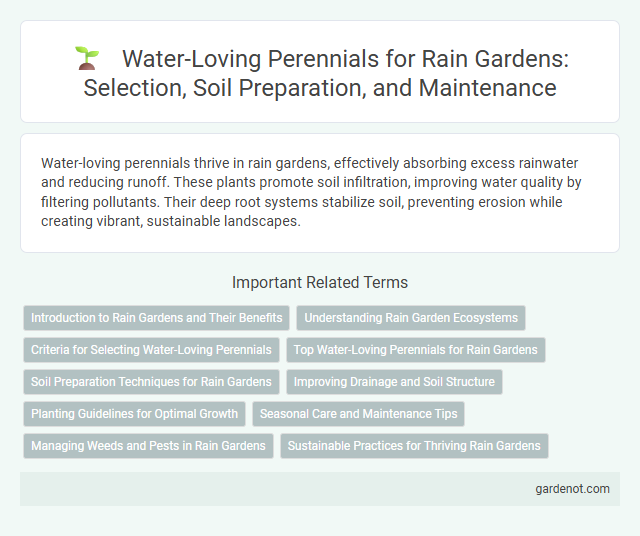Water-loving perennials thrive in rain gardens, effectively absorbing excess rainwater and reducing runoff. These plants promote soil infiltration, improving water quality by filtering pollutants. Their deep root systems stabilize soil, preventing erosion while creating vibrant, sustainable landscapes.
Introduction to Rain Gardens and Their Benefits
Water-loving perennials such as cardinal flower, swamp milkweed, and blue flag iris thrive in rain gardens by absorbing excess stormwater and reducing runoff pollution. These plants improve soil infiltration and promote groundwater recharge, making rain gardens effective natural water management systems. Incorporating native water-loving perennials enhances biodiversity while stabilizing soil and supporting local wildlife habitats.
Understanding Rain Garden Ecosystems
Water-loving perennials such as hostas, blue flag irises, and swamp milkweed play a vital role in rain garden ecosystems by enhancing water filtration and providing habitat for pollinators. These plants thrive in saturated soils, absorbing excess rainwater and reducing runoff, which helps prevent erosion and improves groundwater recharge. Integrating native perennial species into rain gardens supports biodiversity while optimizing ecological functions and resilience.
Criteria for Selecting Water-Loving Perennials
Selecting water-loving perennials for a rain garden requires consideration of moisture tolerance, ensuring plants thrive in consistently damp or periodically flooded conditions. Native species such as Swamp Milkweed (Asclepias incarnata) and Joe-Pye Weed (Eutrochium purpureum) offer adaptability to wet soils and support local ecosystems. Choosing perennials with deep root systems enhances water infiltration and nutrient uptake, optimizing rain garden performance and resilience.
Top Water-Loving Perennials for Rain Gardens
Swamp milkweed (Asclepias incarnata) thrives in wet soil and attracts butterflies, making it an ideal water-loving perennial for rain gardens. Joe-Pye weed (Eutrochium purpureum) offers tall, fragrant clusters of pink flowers that support pollinators and enhance water retention. Cardinal flower (Lobelia cardinalis) provides vibrant red blooms and excellent adaptability to saturated conditions, ensuring a colorful and sustainable rain garden landscape.
Soil Preparation Techniques for Rain Gardens
Water-loving perennials thrive in rain gardens due to well-prepared, nutrient-rich, and well-drained soil that maximizes water absorption and retention. Soil preparation techniques include loosening compacted soil to enhance infiltration, incorporating organic matter such as compost to improve fertility and moisture retention, and grading the garden to direct surface runoff effectively. Proper soil preparation not only supports healthy root development for species like cardinal flower (Lobelia cardinalis) and swamp milkweed (Asclepias incarnata) but also ensures optimal rainwater management and pollutant filtration.
Improving Drainage and Soil Structure
Water-loving perennials such as hostas, astilbes, and joe-pye weed enhance rain garden effectiveness by improving drainage and soil structure through their extensive root systems. These plants increase soil porosity and organic matter, promoting better water infiltration and reducing surface runoff. Incorporating deep-rooted perennials supports healthy microbial activity, which further stabilizes soil composition and boosts moisture retention.
Planting Guidelines for Optimal Growth
Select water-loving perennials such as Joe-Pye weed, Swamp milkweed, and Blue flag iris for rain garden planting to ensure strong moisture tolerance. Plant these species in well-drained, nutrient-rich soil with full to partial sun exposure for optimal growth. Space plants adequately, typically 12 to 18 inches apart, to promote healthy root development and prevent overcrowding.
Seasonal Care and Maintenance Tips
Water-loving perennials in rain gardens require consistent moisture to thrive, especially during dry spells in summer and early fall. Regularly check soil moisture levels and mulch around plants to retain hydration and suppress weeds. Pruning spent blooms and removing dead foliage in late fall promotes healthy growth and prepares the garden for the next growing season.
Managing Weeds and Pests in Rain Gardens
Water-loving perennials in rain gardens require regular monitoring to manage weeds and pests effectively, preventing competition for nutrients and water. Utilizing mulching techniques and selecting native species naturally resistant to local pests can significantly reduce maintenance efforts. Implementing integrated pest management (IPM) strategies ensures a balanced ecosystem, promoting healthy plant growth and sustainable rain garden performance.
Sustainable Practices for Thriving Rain Gardens
Water-loving perennials such as swamp milkweed, Joe-Pye weed, and blue flag iris play a crucial role in sustainable rain garden design by enhancing water absorption and preventing soil erosion. These plants contribute to stormwater management by filtering pollutants and promoting groundwater recharge, making rain gardens effective natural biofiltration systems. Selecting native, deep-rooted perennials ensures long-term resilience, supports local biodiversity, and reduces maintenance demands in thriving rain garden ecosystems.
Water-loving perennial Infographic

 gardenot.com
gardenot.com